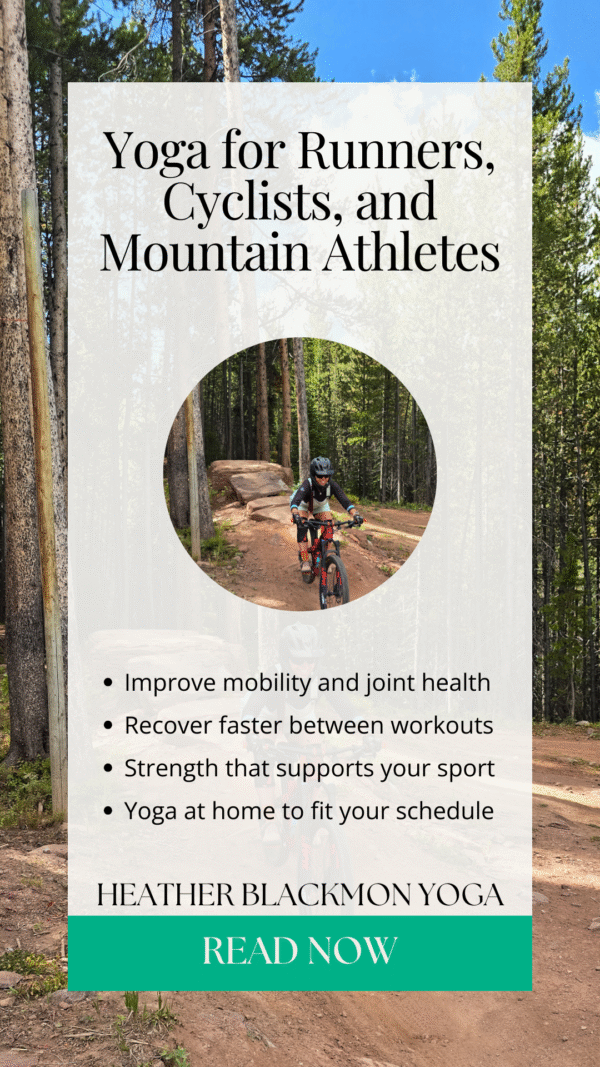You train hard. You stretch when you remember. But your body still feels tight, sore, or stuck more often than you’d like.
If that sounds familiar, here’s something I want you to know: stretching alone isn’t enough.
Whether you’re a runner, cyclist, skier, hiker, or someone who just loves to move outdoors, your body needs more than a quick quad stretch after a workout. You need mobility. You need strength. You need recovery.
That’s where yoga comes in.

Stretching Feels Good, But It’s Not the Whole Picture
Stretching isn’t bad — it can feel amazing after a workout. But passive stretching doesn’t teach your body how to move with strength or control. That’s where it falls short.
Research shows that static stretching may temporarily improve range of motion but doesn’t build the neuromuscular control needed to support that new range (NCBI, 2012).
Without that control, it’s easier to move into unstable positions or compensate with other muscles. That can lead to more tightness or even injury over time.
Mobility = Strength + Flexibility + Control
Mobility is more than flexibility. It’s your ability to move through a full range of motion with strength and control — and yoga trains all three at once.
A well-structured yoga practice improves joint mobility and active flexibility, allowing you to move better, not just farther (Journal of Strength & Conditioning Research, 2016).
Yoga combines movement, strength, balance, and breath awareness — which supports posture, performance, and longevity in your sport.
For example:
- Low lunge builds hip mobility and leg strength
- Downward dog stretches the shoulders and spine while engaging the core
- Balance poses help you strengthen through your full range of motion
This is smart, intentional movement that carries over into your sport.
Recovery Isn’t Rest, It’s Active
Recovery is when your body rebuilds, not just when you’re sitting still. Yoga provides active recovery that supports both your muscles and your nervous system.
Benefits of yoga for recovery include:
- Improved circulation and oxygen delivery to muscles
- Reduced delayed onset muscle soreness (DOMS)
- Parasympathetic activation that supports lower cortisol and improved sleep (Frontiers in Psychology, 2020)
- Reduction in stress and anxiety levels (Harvard Medical School)
Even a short yoga or breathwork session can help your body recover faster and feel better between workouts.
Yoga Makes You a Better Athlete
Yoga isn’t just about recovery — it can make you more efficient, balanced, and focused in your sport.
Studies show that yoga can improve balance, proprioception, breathing efficiency, and mental focus, all of which translate directly to performance (International Journal of Yoga, 2015).
It can also help correct imbalances from repetitive movement patterns (like always pedaling or running in the same direction), reducing the risk of overuse injuries and improving total-body coordination.
You Don’t Need to Be Flexible, You Just Need a Plan
Flexibility is not a requirement — and it’s not even the goal. The goal is to feel good, move better, and keep doing what you love.
You don’t need 60 minutes a day. You don’t need to be able to touch your toes.
You just need a simple plan that supports your training and recovery — and helps you stay consistent.
Where to Start
If you’re ready to stop stretching and start progressing, here are two great places to begin:
- Try the Ultimate Yoga Kickstart Kit. This free beginner-friendly guide includes short flows to help you feel better right away.
- Join Outflow Studio. My online yoga studio is built for active people and includes over 100 classes for strength, recovery, and mobility.
You’re Already an Athlete. Now Move Like One.
You know how to train hard. You already show up.
Now it’s time to give your body what it really needs to perform, recover, and keep going. Not just this season, but for the long haul.
Yoga isn’t extra. It’s essential.
Start today and feel the difference for yourself.






